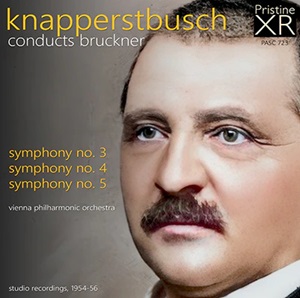
Anton Bruckner (1824-1896)
Knappertsbusch conducts Bruckner
Symphony No 3 in D minor, WAB 103 (1890 ed. Rättig)
Symphony No 4 in E-flat major, WAB 104 ‘Romantic’ (1888 ed. Guttmann)
Symphony No 5 in B-flat major, WAB 105 (ed. 1896 ed. Dobblinger)
Vienna Philharmonic Orchestra/Hans Knappertsbusch
rec. 1-3 April 1954 (No 3) and 29-31 March 1955 (No 4) in mono, Grosser Saal, Musikverein, Vienna, Austria; 3-6 June 1956 (No 5) in stereo, Sofiensaal, Vienna, Austria
Ambient Stereo Remastering (Nos 3 & 4) and XR Remastering (No 5)
Pristine Audio PASC 723 [3 CDs: 174]
These three symphonies are included in the Decca Eloquence box set Hans Knappertsbusch: The Orchestral Edition which I reviewed in 2022, remarking that “Every true Brucknerian will want to own and hear these recordings for the manner in which Kna handles the now superseded Schalk and Loewe versions, demonstrating his natural affinity for Bruckner.” I had previously reviewed the same three symphonies here, when Decca Eloquence issued them in 2020 together with the Eighth, and I again refer you to that review for my assessment of their musical properties. The editions used here are of course all the last revisions; the Third is the product of the version Bruckner made with Schalk, and the Fourth, according to the Bruckner Discography, is “now thought to be chiefly the work of Bruckner himself”, whereas it is thought that the last version of the Fifth employed here was mainly by Schalk and that “Bruckner had very little to do with this revision.” All three – especially the Fifth, which is somewhat mutilated by Schalk’s intervention – are generally truncated, abridged and hard-driven compared with other celebrated recordings of earlier versions, but they are nonetheless invariably subject to Kna’s special gift for animating the scores.
Regarding the sonics, although the Fifth was the only one originally recorded in stereo, I observed in my first review that its sound was still “rather ‘flat’, depriving the Viennese strings of some of their famous sheen, but is still clearly superior to its mono predecessors.” The main issue here, therefore, would at least on the surface seem to be whether the remastering by Andrew Rose of the first two mono recordings into Ambient Stereo and the XR remastering of that Fifth Symphony justify their purchase in this new Pristine issue. In what is now my quite long experience of that label’s output, the answer has hitherto been almost invariably in the positive.
What better place to start a side-by-side sound comparison between the Pristine and Eloquence issues than the epic start of Bruckner’s Third Symphony? Kna’s urgent, driven manner, with phrases slightly clipped to create an aura of breathless tension, sounds terrific in both versions but yes, there is a little more space, ambience reverberation around Pristine’s Third, more depth in the bass and a slight diminution in distortion. I cannot say that I found the addition of any stereo effect by Pristine to be as marked as has been the case with other enhanced mono recordings. Both retain a faint, underlying hiss inherent in the master tape which is not in the least disturbing. Is Pristine’s remastering better? Yes – but so much better? No. I can say that on repeated attempts to concentrate on the differences between them I found myself pleasantly distracted by the mastery of Kna’s manner; resisting engagement with conducting of such intensity is futile.
Perhaps a comparison between Fifths would be more revealing. Beginning with the Decca recording, I was newly struck by its depth and power and began to question why I had previously found it “flat”; it really is first class for its vintage – and here for virtually the first time I can recall, I actually find myself preferring the original to Pristine’s “cleaner” offering, excellent though both are; the original recording is somewhat earthier and more immediate to my ears.
I then moved on to compare the two Fourths. The sound is here is in any case richer than it was for the Third Symphony, presumably because the engineers had refined and improved their recording techniques, equipment or microphone placement and balances over the intervening years – who knows? – but Pristine’s treatment now pays greater dividends than it did for the Third; there is extra “width” of sound and distortion has again been minimised – but once more, the gain is relatively marginal and in fact I am again surprised at how little difference the application of “Ambient Stereo” makes to my appreciation of the recording, when it is usually so clear an advantage.
Such things are very arbitrary and subjective, of course; perhaps the safest advice I can give is that if you love great Bruckner conducting and do not already have these recordings, buying Pristine’s is a good choice – but I would not rush to do so if you already own them on the Decca or Eloquence labels – which also offer the advantage of the original 50s artwork and the Wagner “fillers” which Kna recorded to accompany the Fourth and Fifth Symphonies.
Ralph Moore
Availability: Pristine Classical

















